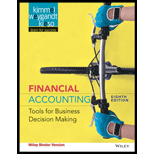
Financial Accounting 8th Edition
8th Edition
ISBN: 9781119210818
Author: Kimmel, Weygandt, Kieso
Publisher: WILEY
expand_more
expand_more
format_list_bulleted
Question
Chapter 10, Problem 10.25E
(a)
To determine
Liabilities
Liabilities are an obligation of the business to pay to the creditors in future for the goods and services purchased on account or any for other financial benefit received. It can be current liabilities or a non-current liabilities depending upon the time period in which it is paid.
To determine: The amount should be reported under current liabilities related to the note on December 31, 2017.
(b)
To determine
To prepare: The amount should be reported under long-term liabilities related to the note on December 31, 2017.
Expert Solution & Answer
Want to see the full answer?
Check out a sample textbook solution
Students have asked these similar questions
Can you explain this general accounting question using accurate calculation methods?
Help with accounting question
Please help me solve this general accounting question using the right accounting principles.
Chapter 10 Solutions
Financial Accounting 8th Edition
Ch. 10 - Prob. 1QCh. 10 - Prob. 2QCh. 10 - Prob. 3QCh. 10 - Prob. 4QCh. 10 - Prob. 5QCh. 10 - (a) Identify three taxes commonly paid by...Ch. 10 - Prob. 7QCh. 10 - Prob. 8QCh. 10 - Contrast these types of bonds: (a) Secured and...Ch. 10 - Prob. 10Q
Ch. 10 - Prob. 11QCh. 10 - Prob. 12QCh. 10 - Prob. 13QCh. 10 - Lee and Jay are discussing how the market price of...Ch. 10 - Prob. 15QCh. 10 - Prob. 16QCh. 10 - Prob. 17QCh. 10 - Prob. 18QCh. 10 - Prob. 19QCh. 10 - Prob. 20QCh. 10 - Prob. 21QCh. 10 - Prob. 22QCh. 10 - Prob. 23QCh. 10 - Prob. 24QCh. 10 - Prob. 25QCh. 10 - Prob. 26QCh. 10 - Prob. 27QCh. 10 - Prob. 28QCh. 10 - Prob. 29QCh. 10 - Prob. 30QCh. 10 - Prob. 31QCh. 10 - Prob. 10.1BECh. 10 - Prob. 10.2BECh. 10 - Prob. 10.3BECh. 10 - Prob. 10.4BECh. 10 - Prob. 10.5BECh. 10 - Prob. 10.6BECh. 10 - Prob. 10.7BECh. 10 - Prob. 10.8BECh. 10 - Prob. 10.9BECh. 10 - Prob. 10.10BECh. 10 - Prob. 10.11BECh. 10 - Prob. 10.12BECh. 10 - Prob. 10.13BECh. 10 - Prob. 10.14BECh. 10 - Prob. 10.15BECh. 10 - Prob. 10.16BECh. 10 - Prob. 10.17BECh. 10 - Prob. 10.18BECh. 10 - Prob. 10.19BECh. 10 - Prob. 10.1ADIECh. 10 - Prob. 10.1BDIECh. 10 - State whether each of the following statements is...Ch. 10 - Prob. 10.3ADIECh. 10 - Prob. 10.3BDIECh. 10 - Prob. 10.4DIECh. 10 - Prob. 10.1ECh. 10 - Prob. 10.2ECh. 10 - Prob. 10.3ECh. 10 - Prob. 10.4ECh. 10 - Prob. 10.5ECh. 10 - Prob. 10.6ECh. 10 - Prob. 10.7ECh. 10 - Prob. 10.8ECh. 10 - Prob. 10.9ECh. 10 - Prob. 10.10ECh. 10 - Prob. 10.11ECh. 10 - Prob. 10.12ECh. 10 - Prob. 10.13ECh. 10 - Prob. 10.14ECh. 10 - Prob. 10.15ECh. 10 - Prob. 10.16ECh. 10 - Prob. 10.17ECh. 10 - Prob. 10.18ECh. 10 - Prob. 10.19ECh. 10 - Prob. 10.20ECh. 10 - Prob. 10.21ECh. 10 - Prob. 10.22ECh. 10 - Prob. 10.23ECh. 10 - Prob. 10.24ECh. 10 - Prob. 10.25ECh. 10 - Prob. 10.1APCh. 10 - Prob. 10.2APCh. 10 - Prob. 10.3APCh. 10 - Prob. 10.4APCh. 10 - Prob. 10.5APCh. 10 - Prob. 10.6APCh. 10 - Prob. 10.7APCh. 10 - Prob. 10.8APCh. 10 - Prob. 10.9APCh. 10 - Prob. 10.10APCh. 10 - Prob. 10.11APCh. 10 - Prob. 10.12APCh. 10 - Prob. 10.13APCh. 10 - Prob. 10.1CACRCh. 10 - Prob. 10.1EYCTCh. 10 - Prob. 10.2EYCTCh. 10 - Prob. 10.3EYCTCh. 10 - Prob. 10.4EYCTCh. 10 - Prob. 10.5EYCTCh. 10 - DECISION-MAKING ACROSS THE ORGANIZATION On January...Ch. 10 - Prob. 10.9EYCTCh. 10 - Prob. 10.10EYCTCh. 10 - Prob. 10.14EYCTCh. 10 - Prob. 10.1IFRSECh. 10 - Prob. 10.2IFRSECh. 10 - Prob. 10.3IFRSECh. 10 - Prob. 10.4IFRSE
Knowledge Booster
Learn more about
Need a deep-dive on the concept behind this application? Look no further. Learn more about this topic, accounting and related others by exploring similar questions and additional content below.Similar questions
- Nevaeh Manufacturing company has a beginning finished goods inventory of $16,200, cost of goods manufactured of $45,800, and an ending finished goods inventory of $18,500. The cost of goods sold for this company is: A. $37,300 B. $45,100 C. $43,500 D. $47,500 Zenith Enterprises has sales of $350,000, cost of goods sold of $190,000, net profit of $15,600, net fixed assets of $170,000, and current assets of $95,000. What is the total asset turnover rate?arrow_forwardI need help with this problem and accounting questionarrow_forwardPlease provide the accurate answer to this general accounting problem using appropriate methods.arrow_forward
- I need help with this general accounting question using standard accounting techniques.arrow_forwardCobalt Industries purchases a milling machine for $12,500. In addition, it incurs a sales tax of $600, shipping costs of $1,200, and $2,300 in labor costs to put the machine in place. The estimated residual value of the machine at the end of its useful life is $900. What is the depreciable base of the machine?arrow_forwardSubject: financial accountingarrow_forward
arrow_back_ios
SEE MORE QUESTIONS
arrow_forward_ios
Recommended textbooks for you
 Financial AccountingAccountingISBN:9781305088436Author:Carl Warren, Jim Reeve, Jonathan DuchacPublisher:Cengage LearningPrinciples of Accounting Volume 1AccountingISBN:9781947172685Author:OpenStaxPublisher:OpenStax College
Financial AccountingAccountingISBN:9781305088436Author:Carl Warren, Jim Reeve, Jonathan DuchacPublisher:Cengage LearningPrinciples of Accounting Volume 1AccountingISBN:9781947172685Author:OpenStaxPublisher:OpenStax College Intermediate Accounting: Reporting And AnalysisAccountingISBN:9781337788281Author:James M. Wahlen, Jefferson P. Jones, Donald PagachPublisher:Cengage Learning
Intermediate Accounting: Reporting And AnalysisAccountingISBN:9781337788281Author:James M. Wahlen, Jefferson P. Jones, Donald PagachPublisher:Cengage Learning

Financial Accounting
Accounting
ISBN:9781305088436
Author:Carl Warren, Jim Reeve, Jonathan Duchac
Publisher:Cengage Learning

Principles of Accounting Volume 1
Accounting
ISBN:9781947172685
Author:OpenStax
Publisher:OpenStax College

Intermediate Accounting: Reporting And Analysis
Accounting
ISBN:9781337788281
Author:James M. Wahlen, Jefferson P. Jones, Donald Pagach
Publisher:Cengage Learning
7.2 Ch 7: Notes Payable and Interest, Revenue recognition explained; Author: Accounting Prof - making it easy, The finance storyteller;https://www.youtube.com/watch?v=wMC3wCdPnRg;License: Standard YouTube License, CC-BY